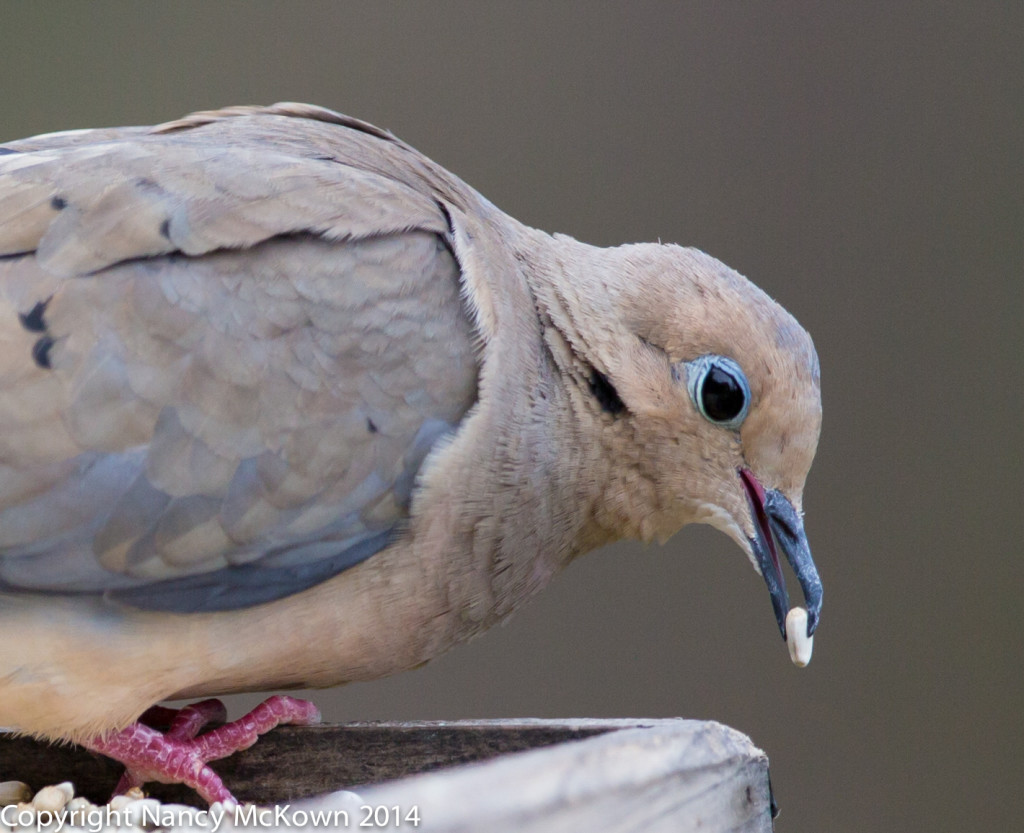Photographing Mourning Doves

ISO 500; f/2.8; 1/800 Second
I just got back from the dentist – and imbibing a dose of Nitrous oxide that had me relaxed and somewhat free to roam from reality.
For the brief time that I was in this mild dreamy state, I could hear the instructions directed to me by the dentist, and obey her, but that interchange came to the forefront of my consciousness reluctantly. A melancholy but alluring song was calling, and I wanted to follow. It was the low, mournful song of Mourning Doves.
Listening to the laments of Mourning Doves in my mind while on the edge of perceived reality seems to me a euphoric experience, and I know why. I associate their songs with the long and lazy summer days of my youth. Hearing Mourning Doves coo is very comforting.

Voracious Eaters at the Feeder
It’s easy to overlook the subtle beauty of Mourning Doves because they are so common. Named for the males’ forlorn sounding courtship calls, these large, plump birds can be found almost anywhere –at feeders, in fields, on the power lines, city sidewalks and parking lots. Mourning Doves are one of the most voracious eaters at the feeder, stock piling one seed after another, without removing the seed casings, until they are full. Digestion comes later when they are resting.
Stray Light May Impact Exposure
On a very sunny and frigid day, with the sun low in the western sky, I set up my camera, tripod and remote on the porch. I wanted to test the impact of stray light coming in through the viewfinder on exposure.
Most cameras come with a rubber mask to place over the viewfinder. I find that the little rubber mask eyecup gets in the way of fine tuning the viewfinder diopter adjustment knob- which I use often to compensate for my very poor vision when not wearing glasses. So I remove the eyecup – and try to be more cautious of the light entering through the back of the camera.
Do Not Remove the Rubber Mask Eyecup
Well, it’s a bad idea to remove the rubber eyecup. When the camera is set to the creative modes (for Canon cameras, Aperture Preferred or Shutter preferred) or any of the automatic modes, and the photographer’s eye is not covering the viewfinder, stray light from behind the camera most certainly will find its way in. This scattered light may influence the light meter into calculating more light than is actually there for exposure. This happens especially during slow shutter exposures. (Manual exposure is not affected by stray light because the photographer sets all 3 exposure indicators.)
I put the little rubber view finder mask back on my camera. I will just have to fuss a bit more when adjusting the viewfinder diopter. (NOTE: Thinking of upgrading to a more comfortable, effective, not in the way eyecup- something that would extend the viewfinder and thus sit more comfortable against my eye and do a better overall job of eliminating stray light.)
To read about overriding your (Canon) camera’s sensor readings, press this link.
To read about the impact of lens flare on your photographs, press this link.
